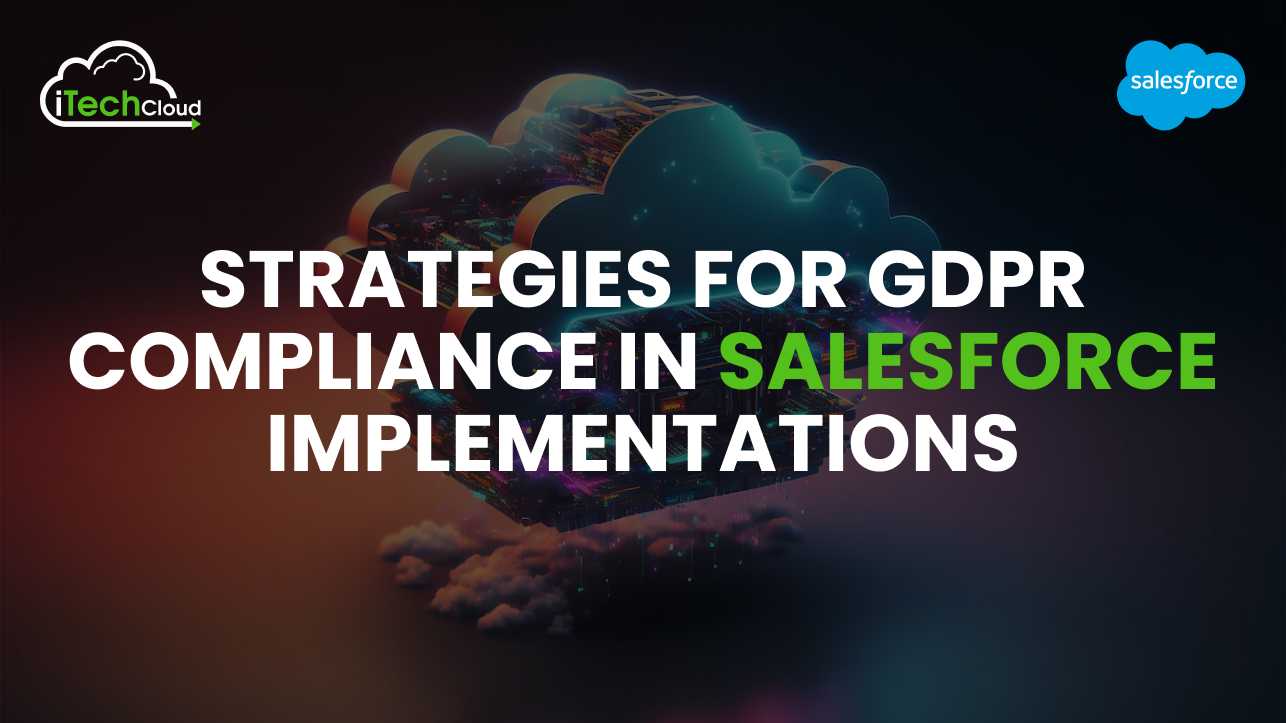
The General Data Protection Regulation (GDPR) has significantly impacted how businesses handle personal data, particularly in the European Union (EU). For organizations using Salesforce, achieving GDPR compliance is not just a legal necessity but also a competitive advantage. This blog explores strategies to implement GDPR compliance effectively within Salesforce environments.
Understanding GDPR
Before delving into compliance strategies, it’s essential to understand what GDPR entails. Enforced since May 25, 2018, GDPR regulates the processing of personal data, emphasizing transparency, accountability, and individuals’ rights over their data. Key principles include:
- Lawfulness, Fairness, and Transparency: Organizations must process personal data legally and transparently.
- Purpose Limitation: Data should only be collected for specified, legitimate purposes.
- Data Minimization: Only the necessary data for a specific purpose should be collected.
- Accuracy: Organizations must ensure that personal data is accurate and kept up to date.
- Storage Limitation: Data should not be kept longer than necessary.
- Integrity and Confidentiality: Personal data must be processed securely.
Key GDPR Compliance Strategies in Salesforce
- Conduct a Data Inventory
The first step toward GDPR compliance is understanding what personal data your organization collects, processes, and stores in Salesforce. Conduct a comprehensive data inventory to identify:
- Types of personal data (e.g., names, email addresses, phone numbers).
- Data sources and how data flows into Salesforce.
- Data storage locations and retention periods.
This inventory will form the foundation for compliance efforts, helping organizations identify areas needing improvement.
- Implement Data Minimization Principles
To comply with GDPR, organizations should implement data minimization principles within Salesforce. This can involve:
- Reviewing data fields in Salesforce and removing any unnecessary fields.
- Implementing validation rules to ensure only required data is collected.
- Training users to collect only essential information from customers.
By minimizing the data collected, organizations reduce the risk of non-compliance and enhance data protection.
- Establish a Clear Data Retention Policy
GDPR mandates that personal data should not be retained longer than necessary. Organizations should establish a clear data retention policy outlining:
- How long different types of personal data will be retained.
- The criteria for determining retention periods.
- Procedures for deleting data that is no longer needed.
Salesforce provides features like data archiving and deletion to help organizations implement these policies effectively.
- Enhance User Consent Mechanisms
Obtaining explicit consent for processing personal data is a critical aspect of GDPR compliance. Organizations should:
- Design user-friendly consent forms integrated with Salesforce.
- Clearly explain the purpose of data collection and processing.
- Provide easy options for users to withdraw consent at any time.
Utilizing Salesforce’s features, like custom objects and record types, can facilitate tailored consent forms.
- Leverage Salesforce Shield for Enhanced Security
Salesforce Shield offers enhanced security features to help organizations comply with GDPR. Key components include:
- Field Audit Trail: Tracks changes to data fields, providing an audit trail for accountability.
- Platform Encryption: Encrypts sensitive data at rest and in transit, ensuring data confidentiality.
- Event Monitoring: Monitors user activities within Salesforce, identifying any suspicious behavior.
Implementing these features can enhance data protection and assist organizations in demonstrating GDPR compliance.
- Facilitate Data Access and Portability Requests
GDPR grants individuals the right to access their personal data and request data portability. Organizations should establish procedures to:
- Easily retrieve personal data stored in Salesforce upon request.
- Export data in a structured, commonly used format.
- Respond to access requests within the mandated one-month timeframe.
Utilizing Salesforce reports and dashboards can streamline the process of generating data for individuals upon request.
- Implement Data Protection by Design and by Default
GDPR emphasizes the principle of “data protection by design and by default.” This involves integrating data protection measures into the development and deployment of Salesforce solutions. Key actions include:
- Conducting privacy impact assessments during the design phase of new Salesforce implementations.
- Regularly reviewing and updating security settings and configurations.
- Involving stakeholders from various departments (e.g., legal, IT, compliance) in the development process.
By prioritizing data protection from the outset, organizations can create more secure Salesforce environments.
- Train Employees on GDPR Compliance
Employee awareness and training are crucial for ensuring GDPR compliance. Organizations should provide regular training sessions covering:
- The key principles of GDPR and their implications for Salesforce users.
- Best practices for handling personal data securely.
- The importance of reporting data breaches or security incidents promptly.
Salesforce offers various training resources and modules that can be customized to meet organizational needs.
- Establish Incident Response and Breach Notification Procedures
In the event of a data breach, GDPR requires organizations to notify the relevant authorities and affected individuals within 72 hours. Organizations should establish clear incident response procedures, including:
- Designating a data protection officer (DPO) or compliance manager responsible for managing data breaches.
- Creating a detailed action plan outlining steps to take in the event of a breach.
- Conducting regular simulations and drills to prepare for potential breaches.
Salesforce provides features for tracking and managing incidents, aiding organizations in their response efforts.
- Monitor and Audit Compliance Regularly
Achieving GDPR compliance is an ongoing process that requires continuous monitoring and auditing. Organizations should:
- Regularly review data processing activities and compliance measures.
- Conduct periodic audits to identify areas for improvement.
- Utilize Salesforce’s reporting tools to track compliance metrics and trends.
Implementing a robust compliance monitoring framework helps organizations maintain GDPR compliance over time.
Conclusion
GDPR compliance is essential for organizations using Salesforce to ensure they handle personal data responsibly and transparently. By implementing these strategies, organizations can navigate the complexities of GDPR effectively while fostering trust and confidence among customers. Proactive compliance not only mitigates risks but also enhances the overall data management practices within Salesforce, creating a more secure and efficient environment for all stakeholders.







